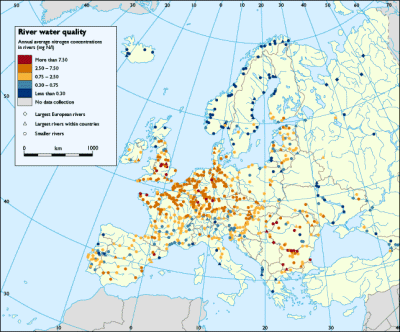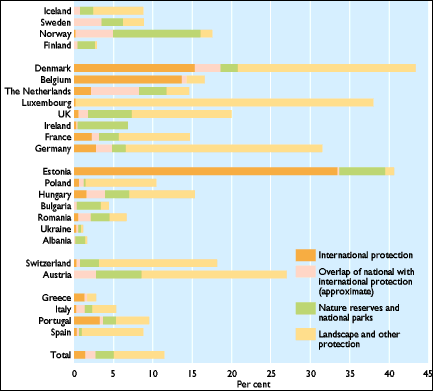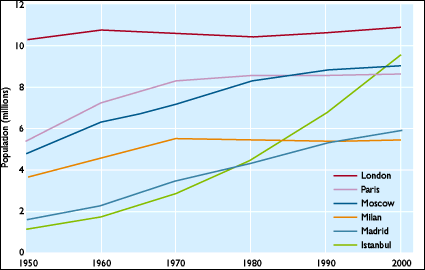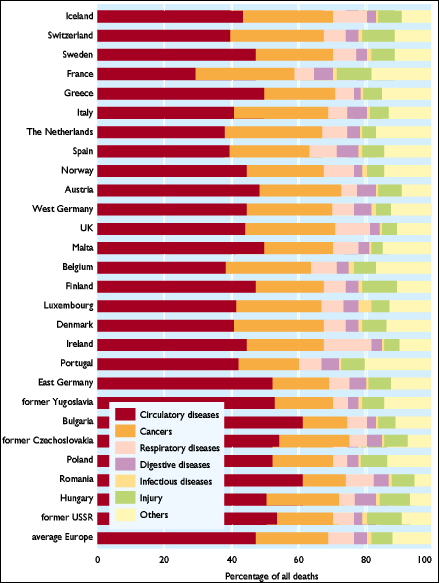4 Air
Presents an overview of the state and trends of the
air in Europe, examining sources, impacts and responses for air
pollutants on local, regional and global scales. Although air quality
is improving in some respects (SO2), in others it is deteriorating. The
impacts of air pollution on human health and the environment are major
European problems and require regulations and conventions to set limits
on emissions
- short-term air pollution exceeds WHO Air
Quality Guidelines at least once a year in most large European
cities
- short-term summer peak levels of ozone affect
more than 100 million Europeans
- critical loads for acidification are exceeded
in more than 60% of Europe's area
- globally, stratospheric ozone depletion and
increased concentrations of greenhouse gases are looming
problems
5 Inland waters
Reviews the state of groundwater, rivers and lakes,
evaluates water quantity and quality trends, and relates both the state
and the trends to natural processes and human activities. Where
possible, the results highlight the condition of inland water in each
European country and provide comparisons of the magnitude of water
issues in different areas of Europe. The data were obtained from many
sources, including national water resource surveys, as a result of EU
legislation, state of the environment reports and the scientific
literature, and from the results of a specially prepared
questionnaire.
 |
| Annual mean nitrogenconcentration in
European rivers |
- on average 15% of Europe's renewable water
resources is abstracted every year, but there are large regional
variations
- industry withdraws about 53%, agriculture 26%
and the domestic sector 19% of the total
- 65% of the population is supplied from
groundwater; in many areas, groundwater is overexploited and its
quality under threat
- estimated nitrate and pesticide levels in soil
water exceed EU drinking water guidelines over much of the
continent
- eutrophication of rivers and lakes is
widespread
- acidification is a severe problem in a large
part of Nordic countries
6 The seas
Evaluates the scale of a series of problems common
to each of Europe's nine major seas - Mediterranean, Black
Sea, Caspian Sea, White Sea, Barents Sea, Norwegian Sea, Baltic Sea,
North Sea, North Atlantic Ocean. The problems are: lack of
effective catchment management; coastal zone pollution; eutrophication;
conflict of uses in the coastal zones; introduction of non-indigenous
species; lack of control of offshore activities; over-exploitation of
resources; and sea level rise as a result of global warming.
 |
Protected areas as percentage of total
country areas |
- all seas, except for sub-arctic ones, face
eutrophication problems. Nitrate has increased two to threefold in some
coastal areas of the Black Sea and the Sea of Azov
- insufficient control of offshore activities is
creating pollution problems in the Black, North and Caspian
seas
- introduction of non-indigenous species had
severe ecological impacts on the Black Sea
- in the Mediterranean, endemic species,
including the monk seal, are endangered
- the Caspian Sea level has risen by 1.5 metres
since 1977
7 Soil
Highlights the major role of soil in the
functioning of ecosystems and the importance of soil protection for the
maintenance of a healthy environment. The functions so performs and how
they are affected by human activities < reviewed and assessed. The
most severe soil degradation processes are overviewed. For each threat,
the main cause magnitude, impacts and remedies are presented. Since the
little quantitative information on soil degradation, most the
assessments are qualitative. Some important quantitave assessments were
calculated from updates of available ms or derived from case
studies.
- soil erosion in Europe affects 115 million ha
causing loss of fertility and water pollution
- critical loads for acidification are exceeded
in 7; million ha of Europe's forest soils
- widespread over-application of fertilisers
result leaching and runoff and leads to eutrophication
8 Landscapes
Provides an overview of the values and functions
that characterize cultural landscapes. Thirty major European landscape
types are differentiated and the geographical locations presented on a
map. Typical landscape stresses are illustrated with case studies. A
portrait of legal and strategic measures for landscape conservation is
given.
- European landscapes are undergoing changes or
disappearing because of agricultural intensification and abandonment,
urban expansion and the development of infrastructure and
transport 6% of Europe's land area is under
landscape protection, but with generally a weak legal
status
9 Nature and wildlife
| Brown bear
Brown bears live in deciduous
and coniferous woods in mountain areas and in plain taiga. In mountain
areas they have a seasonal vertical migration up to altitudes .of 3000
m. Despite their reputation as predatory carnivores, bears feed mainly
on plants, berries, insects, small vertebrates and eggs. They are
generally active at night and live in relatively small areas with a
home range of 500 2500 hectares. Brown bears used to live in all parts
of Europe, from Britain and Spain in the west to the Urals in the east.
Today, they have completely disappeared from most Western and Central
European countries. In the Pyrenees, the Alps and the north of Greece,
only very small isolated populations are left. Brown bears were
generally considered a danger to domesticated livestock and were
persecuted everywhere. However, loss of habitat (large and coherent
forest areas, free of disturbance) is another main reason for their
decline (Council of Europe, 1989).
|
 |
Analyses consecutively the states of ecosystems, fauna and flora,
and nature conservation measures. The main habitat types are described
and the ecological functions of and environmental threats to eight
natural (or quasi natural) major ecosystem types are examined. The
geographic distribution, management qualities and prevailing stresses
are analysed and illustrated. Data for this assessment derive from a
review performed by an expert network. The assessment of Europe's fauna
and flora deals with seven groups of species. Special attention is
given to threatened species according to Red Data lists. For both
ecosystems and species, a number of case studies portray typical
examples and give detailed information to illustrate the overall
findings. Existing as well as potential legal and strategic measures in
nature conservation are reviewed on national and international
scales.
- forests, that once covered 80-90% of Europe,
now account for 33% of land cover
- bogs, fens and marshes have disappeared in
large numbers in Western and Southern Europe - Spain has lost
60%
- between a third and half of all fish,
reptiles, mammals and amphibians in Europe are under threat
- the total area of European protected sites has
trebled since 1972, but most are small and fragmented, and lack funds
and staff for effective protection
10 The urban environment
Examines the quality of the urban environment in Europe and the
impact of cities on the regional and global environment. Experimental
urban environmental indicators are used to identify major problems in
selected European cities. The assessment focuses on urban environmental
quality, flows and patterns. The chapter stresses the need for an
integrated approach to urban areas and examines planning and management
strategies for improving the urban environment.
- two-thirds of Europeans live in urban areas
covering I per cent of the total land area
- urban air quality has improved but is still
frequently unsatisfactory in large cities
- a city of I million inhabitants consumes daily
an average of 11 500 tonnes of fossil fuels, 320 000 tonnes of water
and 2 000 tonnes of food, and produces 25 000 tonnes of CO2, 1 600
tonnes of solid waste and 300 000 tonnes of wastewater
- urban water supply is neither allocated nor
managed efficiently
 |
Population growth in selected European
cities |
11 Human
health
Summarizes the main issues related to the health status of Europeans
and the links between health and the environment. The review is based
on the results of a contemporaneous assessment of environment and
health performed by WHO Concern for Europe's Tomorrow. The simplest
indicator of health is the self-assessment, which show that of 14
European countries the residents of Norway and Sweden are most
satisfied with their health. Other indicators of health are examined,
including life expectancy and infant mortality, and the major causes of
death in Europe - circulatory diseases, cancers, respiratory diseases,
communicable diseases, and injury and poisoning - are reviewed. It
concludes with a review of the major environment-related health
problems in Europe.
 |
Proportional distribution of main causes
of death, 1987-91, by countries (countries ordered by life
expectancy) |
- of all air pollutants, suspended particulate
matter poses the greatest problem to health, provoking asthma an
obstructive airway disease
- bathing water contamination results in more
than 2 million cases of gastro-intestinal diseases annually in
Europe
- Iife expectancy at birth is several years
lower, and the infant mortality rate higher, in Central and Eastern
Europe than in the rest of the continent






Document Actions
Share with others